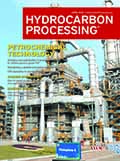
Special Focus: Petrochemical Technology
This case study details the production of tetrahydrofuran (THF), with a purity of 99.96 wt% and water moisture of less than 200 parts per million (ppm).
The steam cracking unit is highly energy demanding, requiring high-severity pyrolysis furnaces to break the carbon-carbon bonds, as well as high pressure for the purification of its products.
Reaction engineering is a branch of chemical engineering that deals with the design and optimization of chemical reactors.
The Assam gas cracker project was proposed as a part of the implementation of the Assam Accord, which was signed on August 15, 1985.
Process Engineering
In the petroleum refining industry, pH measurement and adjustment are extremely important.
Process Optimization
In the conventional development approach, a multi-stage process begins in the laboratory, moves to the pilot plant, and ends at the commercial unit, often before any financial benefits are realized.
Liquid-liquid extraction (LLE) is a traditional method used for separating a specific component (solute) from the carrier liquid phase.
The refining industry is challenged every day to optimize product slates that comply with market demand, product specifications, environmental regulations and refining-petrochemical integration, all while remaining profitable.
Environment and Safety
Corrosion under insulation (CUI) is a common problem that is shared by the oil and gas (onshore and offshore), refining, petrochemical, power and manufacturing industries.
A typical refinery or chemical plant contains miles of pipelines.
Process Control and Instrumentation
Refinery flare stacks are designed to combust all manner of unrecoverable hydrocarbon gases and vapors to avoid putting them into the atmosphere in their original form.
Columns
This issue of <i>Hydrocarbon Processing</i> is devoted primarily to the topic of petrochemicals; and rightly so.
Suppose your manager asked you to be involved in setting up a lube sampling program.
According to BP’s Statistical Review of <i>World Energy 2017</i>, Africa’s total crude oil production is approximately 7.9 MMbpd.
The first petrochemical-based production of ethylene occurred nearly a century ago. Since then, the industry has undergone a momentous evolution.
Some situations in failure analysis demand an understanding of the wave motion of a liquid wave in a tank, called “sloshing.”
Trends & Resources
Over the past decade, the Asia-Pacific region has been the leader in total active projects in all sectors of the downstream processing industry.
Steam crackers lay at the heart of petrochemical operations.
US refinery margins showed seasonal y–o–y growth, mainly supported by gasoline and diesel stocks drawdowns due to refinery maintenance.
According to <i>Hydrocarbon Processing’s</i> Construction Boxscore Database and <i>HPI Market Data 2018,</i> total capital expenditures (CAPEX) in the global petrochemical sector are more than $440 B.
Ross Systems and Controls (SysCon) recently completed the qualification to self-certify its touchscreen purged panels as meeting the rigorous standards of Underwriters Laboratories’ UL-698A Code and the National Fire Protection Association’s NFPA-496 Code.

- Kumho Mitsui Chemicals to increase capacity of MDI production facilities 12/15
- ABS, Eneos, NYK Line and Seacor Holdings launch joint study to develop a methanol marine fuel supply network in the U.S. 12/15
- ENEOS accelerates AI-driven materials discovery of immersion cooling fluids and novel catalysts Using NVIDIA ALCHEMI 12/15
- SAMSUNG E&A wins FEED contract for nearly $5-B SAF plant in the U.S. 12/15
- KBR wins green ammonia project by IGNIS in Spain 12/15
- Phillips 66 announces $2.4-B capital budget for 2026 12/15




